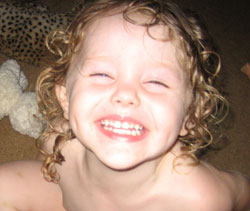So it has been a month and we are STILL waiting for Lily's hearing aid. It was July 10 when we choose Lily's pink
Oticon hearing aid. Our new service coordinator, whom we have never even met, has resigned, and with her resignation comes more waiting for the proper paperwork to go through to get a little financial help with Lily's aid. In reality, Lily needs 2 aids and if we could just get our hands on the first aid then I could talk to the audiologist in person about why she does not think it is important to aid Lily's right ear. Even with a loss as great as hers in her right ear, she would still benefit from stimulating the auditory nerve. It is frustrating because sometimes it feels like we are dealing with people who don't really care every step of the way.
A new
Dora the Explorer doll that can only be held when she is wearing her hearing aid seems to have made the difference today. Lily wore her aid for most of the day. It felt terribly manipulative but we are desperate to get her to wear her aid.
In other news,
Heather Whitestone, the former Miss America, has been bilaterally implanted. Here is a story that came out this week about it:
Life -- now in 'surround sound':Ex-Miss America has 2nd implant to aid hearing
By Chris Emery August 8, 2006Just before doctors turned on her new bionic ear yesterday, Heather Whitestone McCallum saw that her son, John, 6, had lost a baby tooth as he ate a sandwich.
When the device was activated, McCallum got to hear John explain what happened. "A seed in the bread took it off," John said, holding the tooth out to show his mother, who smiled and nodded.
"I like his voice," said McCallum, who underwent cochlear implant surgery six weeks ago at the Johns Hopkins Center for Hearing and Balance in Baltimore and returned yesterday for the activation. It was the most sound she had heard through her left ear since it was damaged by a bout with haemophilus influenza that left her deaf in both ears when she was a child.
McCallum, 33, is an Atlanta resident who in 1995 became the first Miss America with a disability. She had her first cochlear implant, in her right ear, in 2002, and is one of a growing number of people with little or no hearing who opt to have both ears augmented with the devices, which convert sound waves into electrical impulses and transmit them directly to the inner ear.
Strange sounds
After the first operation, McCallum used a hearing aid in her left ear in concert with the implant in her right ear. Some sounds took her a while to identify. Once, sitting in a car with her husband, she heard something she could not identify. "That was me sniffing," he told her.
Other sounds, such as her sons' screaming when they wrestle, were disconcerting. "They weren't in pain, but I had never heard it and didn't know that," she said.
Six months ago, when McCallum completely lost hearing in her left ear, she decided she wanted to get an implant in that ear, as well. "Suddenly, I misunderstood what people were saying to me," she said. "People had to struggle to communicate with me, even my boys."
Having two implants will allow McCallum to hear in "surround sound," an important ability for a mother raising two children, said Dr. John K. Niparko, the Hopkins surgeon who put in McCallum's new implant. Hearing with both ears helps people pinpoint where noises are coming from and focus on one speaker in a noisy room, Niparko said.
He said about 10 percent of the 100,000 people worldwide with implants have them in both ears.
Cochlear implants, developed in the 1970s, now consist of two parts. One is surgically implanted under the skin near the ear, and the other, which is detachable, rests on the ear and is held to the skin by a magnetic attraction between the parts.
Digital signals
The outer portion of the device captures sound waves, converts them into digital signals and beams them across the skin to the internal portion.
From there, minute electrical signals travel down a wire into the cochlea, the snail-shaped portion of the inner ear, where they stimulate the nerve cells connecting to the brain.
When implants were developed, they could stimulate only a few frequencies of sounds in the cochlea. McCallum's implant, on the other hand, can transmit up to 24 frequency bands. "There is a spectrum of sound that is missing, but it is much better than nothing," said Niparko.
The operation, including purchasing the device, costs about $35,000 and is covered by many insurance plans, and by Medicare and Medicaid, he said. People who understand fewer than one-third of words spoken to them might qualify for the implants, he said.
Yesterday, Hopkins staff members first calibrated McCallum's implant by plugging it into a computer and stimulating different tones of sounds inside her ear. Jennifer D. Yeagle, an implant audiologist, tested the 24 frequencies' bands of sound to see which ones McCallum could hear.
"She seems to be hearing the high frequencies better," Yeagle said. "That's because those are the ones her brain hasn't heard in the longest time, so it's noticing them more. As [the neurons] wake up after all these years, they will adapt to what they are hearing."
Later, when the computer was disconnected and the external portion first connected and turned on, McCallum said people's voices sounded high-pitched.
"You sound like a 3-year-old girl," she told Yeagle.
A few minutes later, she said voices were starting to sound more normal and turned on her older implant along with the new one.
"They have their own sound when they are apart, and a different sound when they are together, " McCallum said.
"When they are together, I love it."
________
-Kriste


